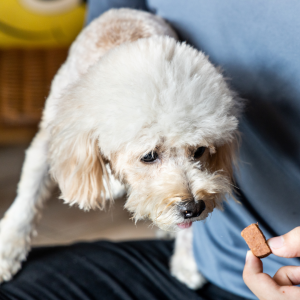Our pets are precious to us, and their safety should always be a priority. Follow these 10 tips to help keep your pet healthy and safe.
You can click on each tip to learn more.
- Tip #1: Prevent heartworm.
- Tip #2: Use pet-safe scents.
- Tip #3: Share food with care.
- Tip #4: Stay away from xylitol.
- Tip #5: Avoid toxic plants.
- Tip #6: Store harmful chemicals.
- Tip #7: Exercise regularly.
- Tip #8: Prepare for storms.
- Tip #9: Keep pets hydrated and out of the heat.
- Tip #10: Visit the vet.

Tip #1: Prevent heartworm.
Heartworms are a deadly parasite that can infect dogs, cats, and ferrets. While dogs can be treated with early detection, a heartworm diagnosis is fatal to cats and ferrets. There are 11 species of mosquito in Florida that are known to vector the parasite.
Preventing heartworms is key to a long and healthy life for your pet. Talk to your veterinarian about options for preventative medicine.
Another way you can help prevent heartworms is to reduce mosquito breeding habitats. Drain any standing water around the home. All it takes is enough water to fill one bottle cap for mosquito larvae to survive.
Make sure to treat any water features, such as bird baths, or water-holding plants, such as bromeliads, in the landscape with Bti, or Bacillus thuringiensis subspecies israelensis. It can be purchased online or at your local home and garden store in the form of bits or dunks.

Tip #2: Use pet-safe scents.
Birds, dogs, cats, and small mammals have a higher sensitivity to smells and can react negatively to the essential oils used in aromatherapy.
Many oils have been noted as toxic, but common ones include:
- Eucalyptus
- Cinnamon
- Citrus
- Pine
- Peppermint
- Tea tree
Certain plug-in air fresheners can also make pets sick over time. Make sure the product you buy is marked as “pet-friendly” to avoid exposing your animals to harmful fumes.
Keeping your home well-ventilated or opting to light candles and incense outdoors can also help prevent overexposure.

Tip #3: Share food with care.
It’s nice to share, but make sure the foods you’re giving your pet aren’t harming them in the long run. Avoid giving them any food that is high in salt or fat, like bacon. If you plan to share your cooked food, prepare it without the use of heavy seasonings, butter, oil, or lard.
There are also a number of foods that are toxic and should not be shared at all.
This includes, but is not limited to:
- Grapes
- Garlic
- Macadamia nuts
- Onions
- Chocolate
- Avocado
Depending on the kind of pet you have at home, sharing some foods may help add variety and supplemental nutrients to their diet. For instance, small pieces of apple (without seeds) and sweet potato make a great treat for dogs!

Tip #4: Stay away from xylitol.
Peanut butter is a common treat for dogs. While the sweet, creamy substance is not an issue on its own (in small amounts), some peanut butters contain xylitol, a sweetener that is toxic to dogs.
Xylitol can quickly lead to hypoglycemia, which is deadly if left untreated. It can also be found in sugar-free candy, toothpaste, mouthwash, and more.
Be sure to check the ingredients on the nutrition label before spooning out a dollop of peanut butter for your dog.

Tip #5: Avoid toxic plants.
While toxic plants pose no threat when left alone in the home or landscape, curious cats and dogs may find themselves in trouble if they try to eat them.
There are several species of plants that may make your pet sick.
Some common ones include:
- Aloe vera
- Amaryllis
- Castor bean
- Chrysanthemum
- Golden pothos
- Hibiscus
- Kalanchoe
- Lily
- Oleander
- Philodendron
- Poinsettia
- Sago palm
- Schefflera
If you do have these plants in your home or landscape, consider adding a barrier or placing them in a hard-to-reach place to prevent accidental munching. Training your pets to avoid these plants can also reduce instances of poisoning.

Tip #6: Store harmful chemicals.
Many common household products may be hazardous to pets, including:
- Laundry detergent
- Dish detergent (especially pods)
- Dryer sheets
- Ammonia
- Bleach
- Some cleaning products
- Certain medications (ex: antidepressants, amphetamines, ibuprofen, aspirin, acetaminophen)
- Batteries
- Paint
- Antifreeze
Outdoors, there are also possible chemical hazards that may pose a risk to your pet if ingested.
These hazards include:
- Some pesticides, such as rodent baits
- Some fertilizers
- Theobromine found in cocoa mulch
- Swimming pool chemicals
In the case of recent applications of pesticides or fertilizer, there is very low risk of harm after the re-entry interval has passed. If concerned, always read the label for instructions on when it is safe to be outside after an application. The safety data sheet (SDS) associated with the product will also provide directions on what to do in case of accidental exposure. The greater danger is to ingest these chemicals in their original form. Make sure to store these substances securely away from your pets.

Tip #7: Exercise regularly.
Just like people, pets need exercise too. It is important to provide stimulating activities in their enclosure or to take them out on walks when possible.
When it comes to walking your dog (or cat), you can explore your neighborhood or take them out to a local park or beach. It may be a great opportunity for you to bond with other pet owners or discover a new favorite place. Just make sure to check that it’s pet-friendly before going! You can find a list of pet-friendly parks by clicking here.
Incorporating toys like tennis balls or frisbees can help serve as a motivator for your pup, and it can provide a safe way to play for those with mobility issues.
Before adventuring outside, check the weather conditions and terrain to see if they may cause any issues for you or your pet. No matter the weather, always bring an adequate supply of water.
For pets that may not be able to safely walk outdoors, such as small mammals, lizards, and birds, adding obstacle courses, tunnels, toys, or providing enriching activities can help maintain their physical and mental health.
Research suggests that exercising your pet regularly can decrease behavioral problems and improve their heart health!

Tip #8: Prepare for storms.
No one likes to think about hurricane season in Florida, but it’s crucial to be prepared for the worst when stormy weather is on the way.
If a hurricane is forecast on the news, make sure you have the following items before temporarily relocating to a shelter:
- Crate/carrier large enough for your pet to stand up and move around and, if needed, to fit a litter box
- Pet collar with identification, and rabies and license tags
- Current vaccination paperwork
- Leash
- Food and water supply for at least two weeks
- Food and water bowls
- A manual can opener
- Cat litter, scoop and plastic trash bags for handling waste
- Pee pads
- Toys, favorite blanket, and treats
- Medications and specific care instructions
- Towels and first-aid supplies
- Photo of you and your pet together
- Consider microchipping your pet
All Sarasota County hurricane shelters are pet-friendly, so you can bring your furry family with you wherever you go. You can visit the Hurricane Evacuation Centers website to see which shelters are closest to you.
After the storm, don’t let your pet wander outside unsupervised where there has been direct impact from the storm. They might encounter harmful insects, such as fire ants, or hazards, like downed power lines.

Tip #9: Keep pets hydrated and out of the heat.
Water is an essential part of life for every animal, including our pets. Make sure to keep a fresh bowl or cup of water in your pet’s enclosure or in another accessible location.
When empty, be sure to refill it promptly. There are many different water-dispensing devices, so if you plan on being away for an extended period of time, consider investing in one that has a large water-holding capacity.
Make sure water containers are cleaned regularly to avoid the growth of algae, bacteria, or mold.
Pets, like people, are susceptible to heat stroke in the hotter months of the year. Beyond making sure that they are well-hydrated, be on the lookout for these symptoms:
- Heavy panting or breathing difficulties
- Lethargy
- Fever
- Vomiting and diarrhea
- Seizure
- Glazed eyes
- Fast heartbeat
- Salivation
- Dark red or purple tongue
- Unconsciousness
If you see these symptoms of heat stroke, move your pet to a shady or air-conditioned area as quickly as possible. You can also apply wet towels or ice packs to your pet’s head, neck, chest, stomach, and feet. Alternatively, you can run cool water over them in the bath or shower. Give your pet small amounts of water at a time. Even if their temperature shows that they are cooling down, take your pet to the vet for immediate monitoring and treatment.

Tip #10: Visit the vet.
Speaking of the vet…there is nothing more important than routine checkups. Your vet will make sure that your pet is up to date on vaccinations for deadly diseases like rabies, prescribe medication for flea and tick prevention, test and treat for parasites, determine potential allergies, and assist with determining underlying issues or causes of chronic pain.
Your vet is your best bet when it comes to giving your pet a long and healthy life! Aim for annual visits at a minimum, and if your pet is showing signs of distress, schedule an individual appointment or make use of an emergency pet clinic, if needed.
Resources:
- tiny.cc/fda_petdangers
- tiny.cc/ahs_heartworm
- tiny.cc/bcspca_oils
- tiny.cc/epa_voc
- tiny.cc/fda_xylitol
- tiny.cc/csu_exercise
- tiny.cc/ufsaraext_petprep
- tiny.cc/ufifasext_heatstroke
- tiny.cc/avma_vet
Learn more:
- Register for our upcoming classes, workshops, trainings, and more: tiny.cc/ufsaraext_ebcite.
- Visit our webpage to learn more ways to protect yourself, your pets, and the environment: tiny.cc/ufsaraext_cite.

 4
4
